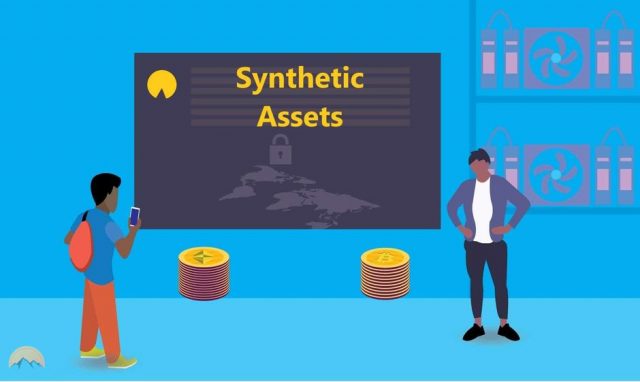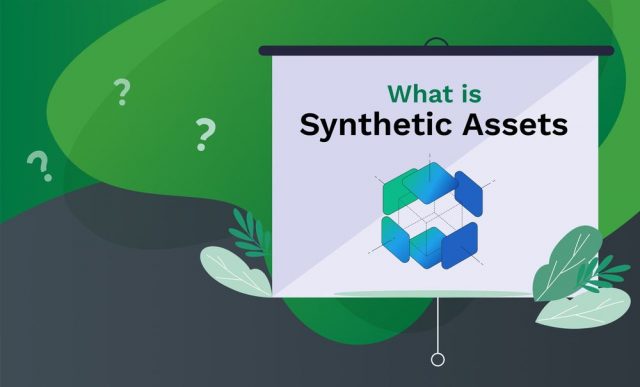Blockchain-based financial instruments known as synthetic assets are designed to imitate the behavior and value of real assets or financial instruments.
Crypto synthetic assets are also known as synthetic assets. They are a class of digital financial instruments developed to mimic the performance and value of real financial assets or assets from the physical world, such as currencies, commodities, stocks, or even cryptos without owning the underlying assets.
The artificial assets are created using complex financial derivatives and smart contracts on blockchain platforms, mostly in decentralized finance (DeFi) ecosystems. The ability to develop decentralized smart contracts on blockchain systems such as Ethereum, track target asset prices precisely, use collateral to secure the value, and create flexible leveraged or derivative products are critical characteristics of crypto synthetic assets.
Decentralized finance users now have access to a wider range of financial markets and assets, which minimizes the dependence on traditional intermediaries. Users need to be careful, though, since these instruments add risk and complexity, necessitating an in-depth knowledge of their underlying operations and impact on investing strategies.
Traditional vs. Crypto Synthetic Assets
Traditional assets are monetary or tangible items like bonds, stocks, and commodities exchanged on established financial markets. On the contrary, crypto synthetic assets are digital representations powered by blockchain technology and intended to resemble the performance and value of traditional assets.
The primary difference between traditional and crypto synthetic assets is that the traditional assets are physical or paper-based, whereas the crypto synthetic assets just exist in digital form on the blockchain networks. While crypto synthetics have several benefits over traditional assets based on accessibility, programmability, and liquidity, they also have distinct complexities and risks.
Related:Techemy Capital Launches DeFi ETP Balancer, Giving Traders Non-Synthetic Exposure to DeFi Assets
Crypto Synthetic Assets Types
Crypto synthetic assets come in different forms, such as leveraged and inverse tokens, tokenized commodities, and equities, synthetic stablecoins, and yield-bearing synthetic assets.
Synthetic Stablecoins
Digital tokens known as synthetic stablecoins are aimed to mimic the value and stability of fiat money, including the Euro and the United States dollar. They offer people a mechanism to exchange services and goods and store value in the crypto ecosystem without experiencing crypto volatility.
One notable example of a synthetic stablecoin is sUSD, which is developed on the Synthetic platform. It strives to offer users enough access to a stable type of digital cash that matches the real value of the U.S. dollar.
Tokenized Commodities And Equities
Stocks and commodities that are tokenized work as digital representations of real-world assets such as oil, gold, stocks, and many other commodities on blockchain platforms. Synthetic assets support decentralized fractional ownership and exchange of traditional assets.
An example of a synthetic asset that mainly tracks the price of crude oil is sOIL, which is also created on the Synthetix platform. Without holding any oil, it lets investors become highly exposed to changes in the price.
Leveraged And Inverse Tokens
Synthetic assets, called leveraged and inverse tokens, are designed to amplify or counteract the price changes of an underlying asset – inverse tokens profit when the underlying asset’s value decreases, while the leveraged tokens magnify losses and profits.
For example, BTC3L (Binance Leveraged Tokens) aims to yield daily returns that are up to three times higher than the price of Bitcoin (BTC). BTC3L needs to gain 3% in case Bitcoin increases by 1%.
Yield-bearing Synthetic Assets
Within the decentralized finance network, yield-bearing synthetic assets give the holders returns via staking or lending, offering an opportunity to generate passive income.
An example of a synthetic asset is cDAI, which is developed by the Compound protocol. Dai (DAI) stablecoins can be offered to participate in lending operations on the Compound platform and earn interest. Since cDAI accumulates interest to holders over time, it qualifies as a yield-bearing synthetic asset.
Crypto Synthetic Assets Applications
Crypto synthetic assets can be used by traders looking for significant profits, investors diversifying their holdings, or decentralized finance aficionados engaged in yield farming.
Trading And Investing Opportunities
Crypto synthetic assets provide a gateway to various trading and investment opportunities. They let traders engage in leveraged trading, intensifying their exposure to market fluctuations and possibly generating more returns (or losses) than they might from more traditional trading.
Moreover, synthetic assets cover many underlying assets within the crypto network, including commodities and stocks, offering investors an easy way to diversify their portfolios.
Liquidity Provision And Yield Farming
The users that stake cryptographic synthetic assets within DeFi protocols can participate in yield farming, earning various incentives in the form of extra synthetic assets or governance tokens for actively participating in DeFi operations and liquidity provision.
Synthetic assets also increase liquidity pools considerably and enhance DeFi platforms’ general liquidity, which is important for facilitating effective trading, borrowing, and lending within the DeFi industry.
Related:YOP Finance Launches Three-Click Yield Farming Platform for DeFi
Hedging Strategies And Risk Management
Synthetic assets offer major risk management tools and hedging potentials. Investors and traders can utilize inverse synthetic assets as effective hedges to shield their portfolios from drops in the underlying assets.
Synthetic stablecoins also provide a decentralized alternative to traditional stablecoins, protecting the value of assets in the wake of the industry’s in-built volatility.
Benefits Of Crypto Synthetic Assets
Crypto synthetic assets offer an assortment of benefits, including leverage, diversification, liquidity augmentation, DeFi engagement, and minimization of risks.
The ability to offer seamless access to various assets, including traditional commodities, stocks, and currencies, is the most critical among these benefits since it lets users diversify their portfolios in the crypto sector, minimizing risk, and enhancing investment strategies.
These crypto synthetic assets also create ways to leverage, enabling traders to increase their exposure to asset price volatility and maybe generate massive returns. They play an integral role in decentralized finance, letting users participate actively in yield farming and liquidity provision and earning various rewards for doing that.
Moreover, these synthetic assets offer the foundation for liquidity pools, enhancing the general liquidity of decentralized finance platforms – a critical component for supporting effective trading and lending activities. The resources also work as critical risk management tools, offering consumers the necessary skills they require to protect all their investments against erratic price volatility.










